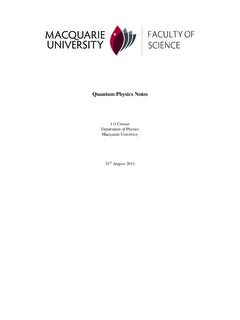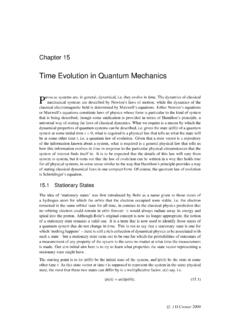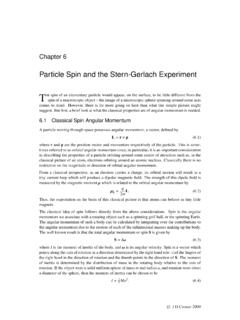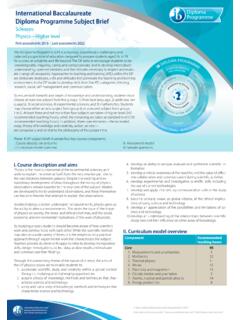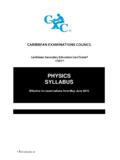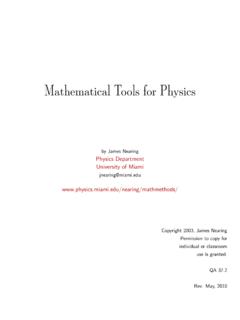Transcription of THE SPECIAL THEORY OF RELATIVITY
1 THE SPECIAL THEORY OF RELATIVITYL ecture Notes prepared byJ D CresserDepartment of PhysicsMacquarie UniversityJuly 31, 2003 CONTENTS1 Contents1 Introduction: What is RELATIVITY ?22 Frames of A Framework of Rulers and Clocks .. Inertial Frames of Reference and Newton s First Law of Motion .. 73 The Galilean Transformation74 Newtonian Force and Newton s Second Law of Motion .. Newton s Third Law of Motion .. 105 Newtonian Relativity106 Maxwell s Equations and the Ether117 Einstein s Postulates138 Clock Synchronization in an Inertial Frame149 Lorentz Length Contraction .. Time Dilation .. Simultaneity .. Transformation of Velocities (Addition of Velocities) .. 2410 Relativistic Relativistic Momentum .. Relativistic Force, Work, Kinetic Energy .. Total Relativistic Energy .. Equivalence of Mass and Energy .. Zero Rest Mass Particles .. 3411 Geometry of Geometrical Properties of 3 Dimensional Space.
2 Space Time Four Vectors .. Spacetime Diagrams .. Properties of Spacetime Intervals .. 411 INTRODUCTION: WHAT IS RELATIVITY ?21 Introduction: What is RELATIVITY ?Until the end of the 19th century it was believed that Newton s three Laws of Motionand the associated ideas about the properties of space and time provided a basis onwhich the motion of matter could be completely understood. However, the formulationby Maxwell of a unified THEORY of electromagnetism disrupted this comfortable state ofaffairs the THEORY was extraordinarily successful, yet at a fundamental level it seemed tobe inconsistent with certain aspects of the Newtonian ideas of space and time. Ultimately,a radical modification of these latter concepts, and consequently of Newton s equationsthemselves, was found to be necessary. It was Albert Einstein who, by combining theexperimental results and physical arguments of others with his own unique insights, firstformulated the new principles in terms of which space, time, matter and energy were tobe understood.
3 These principles, and their consequences constitute the SPECIAL Theoryof RELATIVITY . Later, Einstein was able to further develop this THEORY , leading to whatis known as the General THEORY of RELATIVITY . Amongst other things, this latter theoryis essentially a THEORY of gravitation. The General THEORY will not be dealt with in (both the SPECIAL and General) theories, quantum mechanics, and thermody-namics are the three major theories on which modern physics is based. What is uniqueabout these three theories, as distinct from say the THEORY of electromagnetism, is theirgenerality. Embodied in these theories are general principles which all more specialized ormore specific theories are required to satisfy. Consequently these theories lead to generalconclusions which apply to all physical systems, and hence are of enormous power, as wellas of fundamental significance. The role of RELATIVITY appears to be that of specifying theproperties of space and time, the arena in which all physical processes take is perhaps a little unfortunate that the word RELATIVITY immediately conjures upthoughts about the work of Einstein.
4 The idea that a principle of RELATIVITY applies tothe properties of the physical world is very old: it certainly predates Newton and Galileo,but probably not as far back as Aristotle. What the principle of RELATIVITY essentiallystates is the following:The laws of physics take the same form in all frames of reference moving withconstant velocity with respect to one is a statement that can be given a precise mathematical meaning: the laws of physicsare expressed in terms of equations, and the form that these equations take in differentreference frames moving with constant velocity with respect to one another can be cal-culated by use of transformation equations the so-called Galilean transformation in thecase of Newtonian RELATIVITY . The principle of RELATIVITY then requires that the transformedequations have exactly the same form in all frames of reference, in other words that thephysical laws are the same in all frames of statement contains concepts which we have not developed, so perhaps it is best atthis stage to illustrate its content by a couple of examples.
5 First consider an examplefrom everyday experience a train carriage moving smoothly at a constant speed on astraight and level track this is a frame of reference . Suppose that in this carriage is apool table. If you were a passenger on this carriage and you decided to play a game ofpool, one of the first things that you would notice is that in playing any shot, you wouldhave to make no allowance whatsoever for the motion of the train. Any judgement ofhow to play a shot as learned by playing the game back home, or in the local pool hall,1 INTRODUCTION: WHAT IS RELATIVITY ?3would apply equally well on the train, irrespective of how fast the train was moving. Ifwe consider that what is taking place here is the innate application of Newton s Laws todescribe the motion and collision of the pool balls, we see that no adjustment has to bemade to these laws when playing the game on the moving argument can be turned around. Suppose the train windows are covered, and thecarriage is well insulated so that there is no immediate evidence to the senses as to whetheror not the train is in motion.
6 It might nevertheless still be possible to determine if thetrain is in motion by carrying out an experiment, such as playing a game of pool. But,as described above, a game of pool proceeds in exactly the same way as if it were beingplayed back home no change in shot-making is required. There is no indication fromthis experiment as to whether or not the train is in motion. There is no way of knowingwhether, on pulling back the curtains, you are likely to see the countryside hurtling by,or to find the train sitting at a station. In other words, what the principle of relativitymeans is that it is not possible to determine whether or not the train carriage is idea can be extended to encompass other laws of physics . To this end, imagine acollection of spaceships with engines shut off all drifting through space. Each space shipconstitutes a frame of reference , an idea that will be better defined later. On each ofthese ships a series of experiments is performed: a measurement of the half life of uranium,a measurement of the outcome of the collision of two billiard balls, an experiment inthermodynamics, a measurement of the specific heat of a substance, a measurementof the speed of light radiated from a nearby star: any conceivable experiment.
7 If theresults of these experiments are later compared, what is found is that in all cases (withinexperimental error) the results are identical. In other words, the various laws of physicsbeing tested here yield exactly the same results for all the spaceships, in accordance withthe principle of , quite generally the principle of RELATIVITY means that it is not possible, by consideringany physical process whatsoever, to determine whether or not one or the other of thespaceships is in motion . The results of all the experiments are the same on all the spaceships, so there is nothing that definitely singles out one space ship over any other as beingthe one that is stationary. It is true that from the point of view of an observer on any oneof the space ships that it is the others that are in motion. But the same statement can bemade by an observer inanyspace ship. All that we can say for certain is that the spaceships are in relative motion, and not claim that one of them is truly stationary, while theothers are all truly principle of RELATIVITY was accepted (in somewhat simpler form with respect tothe mechanical behaviour of bodies) by Newton and his successors, even though Newtonpostulated that underlying it all was absolute space which defined the state of absoluterest.
8 He introduced the notion in order to cope with the difficulty of specifying withrespect to what an accelerated object is being accelerated. To see what is being impliedhere, imagine space completely empty of all matter except for two masses joined by aspring. Now suppose that the arrangement is rotated, that is, they undergo , in accordance with our experience, we would expect that the masses would pullapart. But why should they? How do the masses know that they are being rotated?There are no signposts in an otherwise empty universe that would indicate that rotationis taking place. By proposing that there existed an absolute space, Newton was able toclaim that the masses are being accelerated with respect to this absolute space, and hencethat they would separate in the way expected for masses in circular motion. But thiswas a supposition made more for the convenience it offered in putting together his Lawsof motion, than anything else.
9 It was an assumption that could not be substantiated, as1 INTRODUCTION: WHAT IS RELATIVITY ?4 Newton was well aware he certainly felt misgivings about the concept! Other scientistswere more accepting of the idea, however, with Maxwell s THEORY of electromagnetism fora time seeming to provide some sort of confirmation of the of the predictions of Maxwell s THEORY was that light was an electromagnetic wavethat travelled with a speedc 3 108ms 1. But relative to what? Maxwell s theorydid not specify any particular frame of reference for which light would have this convenient resolution to this problem was provided by an already existing assumptionconcerning the way light propagated through space. That light was a form of wave motionwas well known Young s interference experiments had shown this but the Newtonianworld view required that a wave could not propagate through empty space: there mustbe present a medium of some sort that vibrated as the waves passed, much as a stringvibrates as a wave travels along it.
10 The proposal was therefore made that space was filledwith a substance known as the ether whose purpose was to be the medium that vibratedas the light waves propagated through it. It was but a small step to then propose thatthis ether was stationary with respect to Newton s absolute space, thereby solving theproblem of what the frame of reference was in which light had the speedc. Furthermore,in keeping with the usual ideas of relative motion, the thinking then was then that if youwere to travel relative to the ether towards a beam of light, you would measure its speedto be greater thanc, and less thancif you travelled away from the beam. It then cameas an enormous surprise when it was found experimentally that this was not, in fact, discovery was made by Michelson and Morley, who fully accepted the ether THEORY ,and who, quite reasonably, thought it would be a nice idea to try to measure how fastthe earth was moving through the ether.
